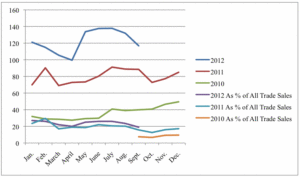The AAP released their monthly StatShot report for September 2012, with data from close to 1200 publishers, and as they state, it “reflects the trends we’ve seen all year: continued publishing growth overall with significant increases in children’s/young adult (especially eBook format) and slight erosion in religion publishing.”
For September, however, children’s and YA books fell 4.2 percent (the big growth came earlier in the year) at $145.6 million overall, while net adult book sales of $468.1 million were up 2.8 percent–but that was due to reduced returns rather than higher gross shipments. So for the month, net trade sales of $613.7 million were up 1 percent from a year ago.
Adult hardcovers rose 3 percent, at $179.8 million, while trade paperbacks fell 8.7 percent, to $124.7 million. eBooks were the third-largest segment for adult books, at $103.9–a 30.7 percent increase over $79.6 million a year ago, also consistent with the year’s pattern that has had ebook sales growth slowing down considerably. Children’s ebooks added another $12.9 million, up 44 percent from $8.9 million a year ago.

More importantly, ebooks were down 11.5 percent compared to the prior month, returning to pre-Fifty Shades levels, the lowest recorded month since April. (Last year, the ebook trough came in October, and then the market rose again.) And ebooks comprised just 19 percent of trade sales for the month–their lowest percentage since December 2011.
There’s also an important statistical variation to remember when looking at the ebook numbers from September forward: Harper switched to post-settlement “agency lite” on September 11, and more so than the other Settlers who changed models later in the year, they boosted their consumer prices. (It seemed, from our random samples at the time, that their prices could have gone up as much as 30 percent.)

Since AAP StatShot reflects publisher receipts, the ebook numbers will be slightly higher without any change in the market itself. So the 32 percent year-over-year growth for the combined ebook market of $116.8 is overstated relative to unit sales. If we could perform a pricing-model-neutral comparison of September 2012 to September 2011, market growth would be lower still; more on the order of, say, 27 percent.
AAP stats also show just weak the K-12 market has been (a good part of the reason why McGraw-Hill Education sold for a discounted price recently): Those sales were $240 million–42 percent lower than the $412 million recorded a year ago.